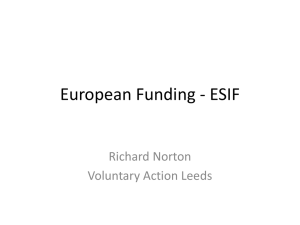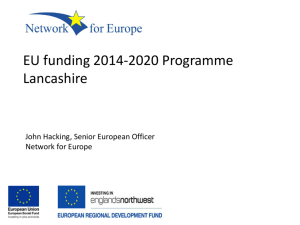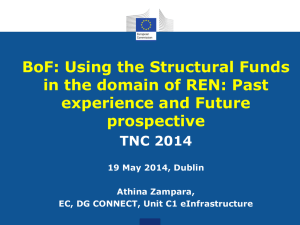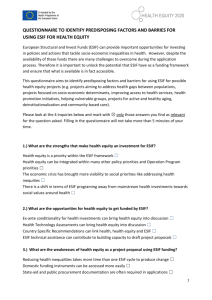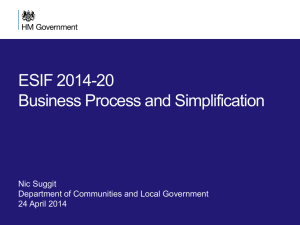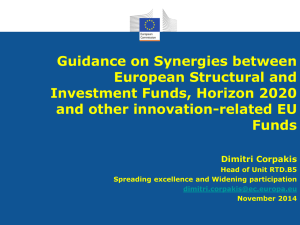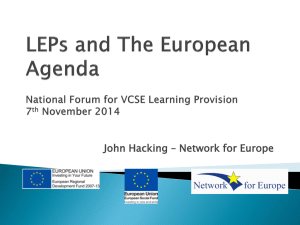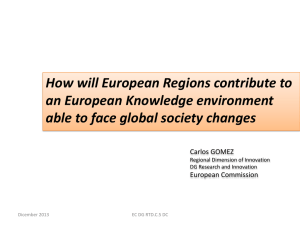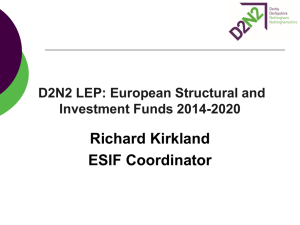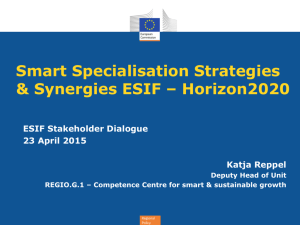3LE Presentation - Third Life Economics
advertisement
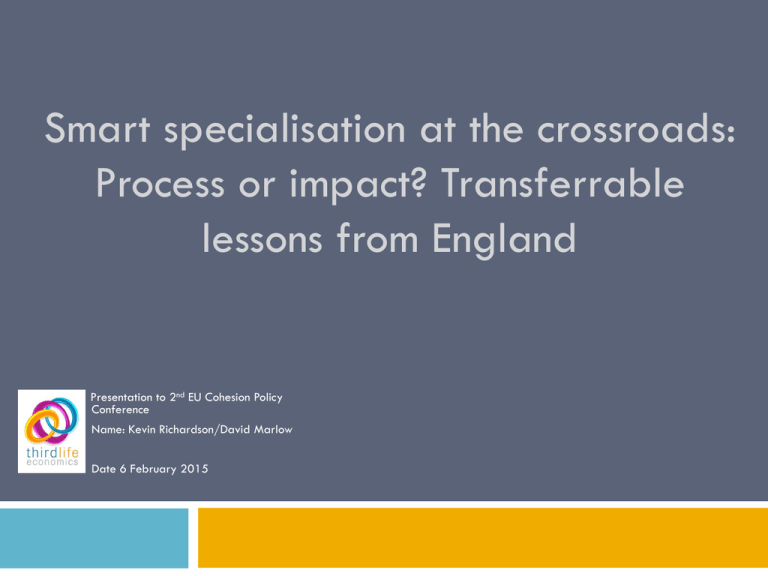
Smart specialisation at the crossroads: Process or impact? Transferrable lessons from England Presentation to 2nd EU Cohesion Policy Conference Name: Kevin Richardson/David Marlow Date 6 February 2015 Innovation Context: England Very high absolute levels of R&D; but low (overall) relative to EU2020 target of 3% of GDP Very strong universities but weaker in commercialisation, with relatively lower levels of investment by businesses Government maintains cash investment in science, and significant fiscal incentives; despite tough pending cuts elsewhere R & D concentrated in limited number of sectors; dominated by large firms Very significant and regional disparities in investment in innovation Complex Policy Context National National Innovation & Research Strategy and national Industrial Strategy National Industrial Strategy focus on 11 Sectors and 8 Great Technologies Significant horizontal tax measures (R & D Tax Credits, Patent Box) Independent Review of Universities and Growth by Sir Andrew Witty, CEX of GSK plc Local ‘Localism’ – a view that government had become too centralised, ‘bottom-up’ decisions to be taken by local (functional economic) level Local Strategic Economic Plans; & local proposals for ESIF upon which Operational Programmes to be aggregated No explicit mandate for local areas to develop innovation policy, but obvious expectation from partners (including mandatory thematic concentration of ESIF) Complex Institutional Context National Department of Business, Innovation & Skills as policy lead and main funder Research Councils – explicitly based on excellence Innovate UK as single national innovation agency and funding programmes (largely aspatial) Catapult Centres, located around UK with mandate to provide a national service (loosely based on Fraunhofer) Dept. of Communities & Local Government as Managing Authority for ESIF Local Abolition of RDAs (inc. Science and Industry Councils and targeted investment budgets) 39 Local Enterprise Partnerships, often with limited executive capacity Strong university sector; a varied mix of research intensives and many locally embedded institutions Capacity issues in some regions in local business leadership Capacity of many local municipalities impacted by major budget cuts Smart Specialisation in England A single national strategy for England Based on 10 sectors and 8 Great Technologies in Industrial Strategy Presented as a smart specialisation compliant ‘menu’ form which local partnerships can prioritise Locally niche specialisms only with sound evidence and sufficient scale/impact Peer Reviewed in Riga (‘14) Mixed evidence…………. (positive) Guidance / encouragement to local partnerships ‘Bottom up’ approaches, especially in areas with higher ESIF allocations e.g. Manchester, North East etc National Smart Specialisation Sub Committee of PMC Commitment in national Innovation Strategy for Smart Specialisation Advisory Hub Pivotal in (re)engaging universities in ESIF Mixed evidence…………. (a critique) Approx. €120m ESIF pa compared to €35 billion gross expenditure on R&D General lack availability of quality data Issues of collaboration across boundaries to build scale and impact Impact on aspatial policies and funding agencies (EU and national)? Local motivations unclear and some local resistance Issues of capacity at all levels Recommendation #1 Continue development and testing new and wider S3 tools and techniques Why? Current tools tend to be simplistic and qualitative (e.g. SWOT). Very difficult to assess whether innovation strategies are ‘smart’ or not What Next? Commission programmes (at EU, national and local levels) to develop new, accessible tools for innovation-led growth strategy formulation and delivery management Recommendation # 2 Invest in capacity-building and deliberative exchange between EU, national and local innovation leadership teams Why? Many innovation leadership teams lack capacity and capability to plan and mange change effectively. Many have a breadth of world views and perspectives, with limited mechanisms for building shared understandings and agreements on priorities What Next? Support for Seville S3 ‘platform’ programmes, e.g. the England Advisory Hub with resources (including ESIF co-financing) to encourage collaborative capacity building and knowledge exchange Recommendation # 3 Strengthen the evidence base and modelling of performance of local innovation eco-systems Why? No strong consensus on ‘what good looks like’, and how local innovation systems are currently performing. New innovation economies are not well-captured by existing Eurostat and national data sets What Next? Update understandings of the KPIs and data requirements for measuring and analysing innovation systems. Test and pilot new data collection and analysis techniques through the 2014-2020 EU (and national) programmes Recommendation #4 and #5 Broaden the scope of any S3 conditionality across all major EU programmes (and ideally national public investments) Why? One ERDF thematic objective is a small % of overall investment in RD&I. Investments need to be aligned with skills, infrastructure and other investments. There is limited scope to reinforce S3 practice if conditionality is approved ‘ex-ante.’ What Next? EU Commission, MS and regional partners to determine future application of S3 conditionalities across EU investment programmes. Strengthen incentives for aligning funds (ESIF, H2020 etc.) along broadly-S3-based principles. Monitor and evaluate increased synergy ‘pilots.’ Two observations.. What do we think S3 really is? ...a way of thinking ...a strategic processbased approach ...a ‘model’ or set of models ...an ESIF assurance device ...something else and/or a hybrid of many things How transferrable is the England experience? A ‘sui generis’ outcome of specific political and institutional contexts... An exemplar of tensions inherent in more successful innovation economies, and relationships between regions in that economy A more general set of transferrable experiences and lessons Thank you for accepting our paper and our presentation in English DavidMarlow@thirdlifeeconomics.co.uk
